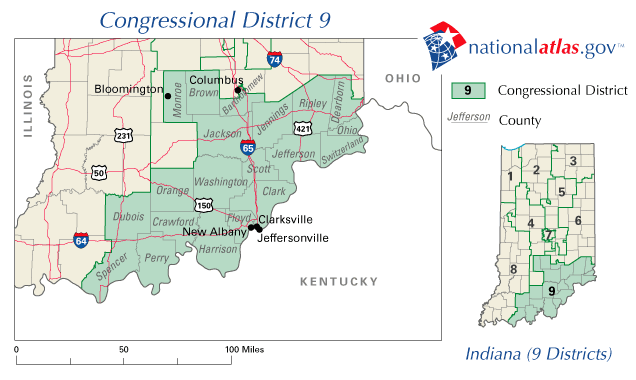 |
 |
 |
 |
 |
| |
| Get email
updates right in your inbox! |
 |


| Government and Local Links
Links to Government and Local websites |

|
| Indiana’s Ninth District stretches along the Ohio River from Dearborn County in the east to Spencer County in the west. It includes the Hoosier National Forest and some of Indiana’s most beautiful landscapes. Dearborn County, near Cincinnati, Ohio includes the river towns of Lawrenceburg and Aurora. Just south of Dearborn County is Ohio County, Indiana’s smallest county, but home to the beautiful community of Rising Sun. South of Ohio County is Switzerland County, which was founded by Swiss immigrants who found the Ohio River hillsides particularly favorable for growing grapes. To the West is Ripley County with Versailles as the county seat. Ripley County is home to the community of Milan, made famous by the 1954 Milan Indians High School Basketball team that defeated Muncie Central in the State Basketball Finals. The ’54 Milan Team, long a part of Indiana basketball lore, was immortalized for basketball fans nationwide with the release of the movies “Hoosiers” in 1986. The fictionalized movie, written by Indiana native Angelo Pizzo, and starring Gene Hackman, Barbara Hershey and Dennis Hopper is one of the best-loved sports movies of all time. West of Ripley County are Jennings and Jackson counties, home to some of the state’s best farm land and the Muscatatuck National Wildlife Refugee. North of Jackson County is Bartholomew County. Columbus, in Bartholomew County, is especially known for its architecture thanks, in part, to the Cummins Engine Foundation. Over 50 public and private buildings by world renowned designers comprise the most concentrated collection of contemporary architecture in the world. Columbus has earned worldwide recognition for its modern architecture. In 1991, the American Institute of Architects surveyed 829 of its members. They ranked Columbus sixth among U.S. cities in architectural quality and innovation. Only Chicago, New York City, Washington, DC, San Francisco, and Boston were ranked higher in the survey. (source: Columbus Chamber of Commerce) West of Bartholomew County is Brown County. In the early 1900s, Indiana artist T.C. Steele “discovered” Brown County. Steele invited his friends and fellow artists to visit, and word of this phenomenal place soon spread. Brown County quickly became the “Art Colony of the Midwest” – not unlike similar art centers being founded across the country at that time. But one thing made Brown County unique – even among the other American artists’ communities: Brown County was already a snug and settled home town to many families who had lived here for generations. A hometown the rest of the world had hustled past. Hometown to folks who readily shared their land and food, crafts and humor; who gently and genuinely welcomed these new residents and visitors to share in the tranquil beauty that surrounded them. (source: Brown County CVB) West of Brown County is Monroe County, home to the city of Bloomington and Indiana University, Time magazine’s 2001 “College of the Year” among research institutions. The population center of the Ninth District is located in the communities across the Ohio River from Louisville, Ky in Clark County and Floyd County. Northeast of Clark County is Jefferson County home to the historic town of Madison. In the mid-1800’s, all the world seemed to pass through Madison. This booming city nestled in the Ohio River Valley, was the center of transportation, industry and commerce for the entire region. More than 150 years later, much that was special and unique about Madison and Jefferson County then remains unchanged now. Boats and barges still pass on the great northern bend of the Ohio River, surrounded by scenic limestone bluffs. The hills are still tree-covered and the farmlands are still fertile. Many of the grand homes and historic commercial buildings are still in use. For the last 55 years Madison has hosted the Madison Regatta, unlimited hydroplane racing now sanctioned by the American Boat Racing Association. The Madison Regatta was the subject of the recently released movie, “Madison,” starring Jim Caviezel, Jake Lloyd, Mary McCormack and Bruce Dern. The 1958 Frank Sinatra and Dean Martin film, “Some Came Running,” was also set and filmed in Madison. West of Jefferson County are Scott and Washington counties, where you can find several state parks and the quintessential southern Indiana rolling hills and farmland. Down the river from Floyd County is Corydon in Harrison County. From 1816-25 Corydon served as the first state capital of Indiana. In June of 1816, 43 delegates met in Corydon to draft the first state constitution. Much of their work was done under the shade of a huge elm tree. The trunk of the tree, now known as the “Constitution Elm,” is still standing. In November of 1816, the first General Assembly of 29 representatives, 10 senators and the lieutenant governor met in the capitol building. On December 11, 1816, Indiana was admitted as the 19th state. Corydon remained the state capital until the seat of government was moved to Indianapolis on December 10, 1825. At that time, the capitol building became the Harrison County Courthouse. (source: Indiana State Museum) West of Harrison County is Crawford County, home to the Wyandotte Caves. Near the town of Leavenworth, also in Crawford County, and along State Road 62, you can pull over and view a spectacular overlook of the Ohio River. South of Crawford County is Perry County, where communities like Tell City, Cannelton and Derby sit along the Ohio River bank and the Hoosier National Forest stretches north along State Road 37. North of Crawford County is Orange County. The communities of French Lick and West Baden, known collectively as Springs Valley, share a long and fascinating history, beyond native son Larry Bird. The towns were built around lavish resort hotels and in West Baden it was the West Baden Springs Hotel, now referred to as the West Baden Springs National Historic Landmark. It took architect Harrison Albright only 277 days in 1902 to complete the current West Baden Springs Hotel for owner Lee Wiley Sinclair. The structure features a 200-foot domed atrium, the largest free-span dome in the world until the Houston Astrodome was built in 1968. In 1897, Indianapolis Mayor and National Democratic Committee Chairman Thomas Taggart began construction on what is now the French Lick Springs Resort and Spa. Under Taggart, the entire town of French Lick thrived, mainly because the influx of tourist traffic that came to drink the waters which were believed to contain healing powers. Until the stock market crash and the Great Depression, the town of West Baden had earned from travelers the nickname of "The Monte Carlo of America." The West Baden Springs Hotel brought the rich and famous (and even the infamous gangster Al Capone) to the area. Wealthy travelers from cities like Chicago, Indianapolis, Cincinnati, and routinely made their way to West Baden and French Lick via the Monon and B&O railroad lines. To the west of Orange County, along State Road 56, is Dubois County. Dubois County, settled primarily by families of German ancestry, Dubois County’s pride in it’s German heritage can be found at the annual Jasper Strassenfest and the Schnitzelbank Restaurant. Ferdinand is home to the beautiful Monastery Immaculate Conception. The "Castle on the Hill" is home to one of the nation's largest communities of Benedictine women in the United States. Its striking presence, soaring beauty, and amazing detail are a testament to the faith and dedication of the Benedictine sisters who sacrificed for it and the vision and craftsmanship of those who built it. The sisters live the 1500 year-old monastic tradition of the Rule of St. Benedict, a spiritual path for finding God in the ordinary circumstances of daily life. Their guiding principles are prayer, work, hospitality, and a community life. (source: Dubois County Tourism Commission) South of Dubois County is Spencer County, the western-most county in the ninth district. As a young boy, Abraham Lincoln lived with his family on a farm near Gentryville in Spencer County. Lincoln and his family moved to Indiana in 1816 and stayed until 1830 when they moved on to Illinois. During this period, Lincoln grew physically and intellectually into a man. The people he knew here and the things he experienced had a profound influence on his life. His sense of honesty, his belief in the importance of education and learning, his respect for hard work, his compassion for his fellow man, and his moral convictions about right and wrong were all born of this place and this time. The time he spent here helped shape the man that went on to lead the country. It was from Rockport, in Spencer County, that Lincoln set off for his journey down the Ohio and Mississippi rivers to New Orleans, where Lincoln first witnessed slavery. (Source: National Park Service, Lincoln Boyhood National Memorial) |
 |
|
| Biography | District | News | Issues | Services | Recent Votes | Photos | Kids Page | Contact | Home | |
Webmaster: support@rcsinteractive.com